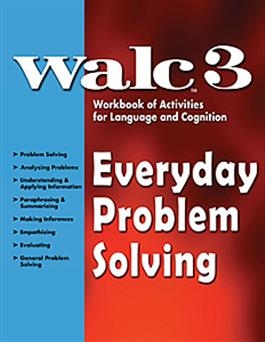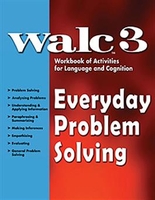WALC 3 Everyday Problem Solving

Materials to Download
To see more of this product's contents:
WALC 3 Everyday Problem Solving
Ages: Adults
Practice seven specific problem solving skills in isolation. Then, apply them to depicted situations and generate and evaluate solutions.
Written in the best-selling format of the Workbook of Activities for Language and Cognition series, these activities have:
- easy-to-read format
- simple, concise language
- consistent progression of complexity within and between tasks
- application to a wide range of acquired cognitive-language disorders
Focus on the cognitive processes and strategies used in problem solving. Hundreds of problem scenarios are presented based on common themes of money, work, family and social relationships, health and safety, and sports and leisure. Multiple-choice and open-ended questions guide clients to practice the targeted skills.
The first section of the book gives practice in these skills:
- Problem Solving - Identify a problem statement based on a brief scenario. Generate a quick solution based on limited information.
- Analyzing Problems - Clients study scenarios based on everyday activities. Many of the scenarios are based on functional reading such as advertisements, receipts, prescription labels, and sports schedules. The activity questions prompt clients to think about details that will help solve the depicted problems.
- Understanding & Applying Information - Identify information that is useful for problem-solving and apply it to depicted situations.
- Paraphrasing & Summarizing - Clients restate information in their own words. In the process, they identify the most important information. This skill helps them arrive at quicker solutions in problem solving.
- Making Inferences - Clients learn to consider all the factors when they make inferences in a variety of depicted situations.
- Empathizing - Clients consider the feelings of others and their own feelings as they analyze problems.
- Evaluating - Clients weigh the solutions to problems, paying close attention to details.
The last section of the book gives practice in integrating the above skills. Real-life problems are presented in a brief article, similar to something you might read in a local newspaper. Clients use the information in the article, the corresponding picture, and their own experience to approach the problems effectively.
191 pages • 8.5 x 11 • softcover • ©2003


